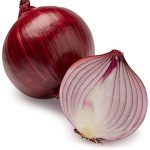 A labour union brings together many different individuals; a garden onion has many tightly bound layers. This connection explains why both words—union and onion—derive from the Late Latin unio, meaning oneness or unity, which in turn arose from the Latin unus, meaning one. The earliest English spellings of the bulb’s name—unyonn back in the fourteenth century—suggest that medieval authors were more aware of the connection between onion and union than we usually are. In fact, had the connection between onions and oneness not been lost in the intervening centuries, we might be tossing onions, instead of rice, when the bride and groom descend, newly united, from the church steps. Incidentally, the ancient Romans also used the Latin unio to mean pearl, because pearls, like onions, are made up of many layers united into a single sphere. The term pearl onion, therefore, is in one sense redundant.
A labour union brings together many different individuals; a garden onion has many tightly bound layers. This connection explains why both words—union and onion—derive from the Late Latin unio, meaning oneness or unity, which in turn arose from the Latin unus, meaning one. The earliest English spellings of the bulb’s name—unyonn back in the fourteenth century—suggest that medieval authors were more aware of the connection between onion and union than we usually are. In fact, had the connection between onions and oneness not been lost in the intervening centuries, we might be tossing onions, instead of rice, when the bride and groom descend, newly united, from the church steps. Incidentally, the ancient Romans also used the Latin unio to mean pearl, because pearls, like onions, are made up of many layers united into a single sphere. The term pearl onion, therefore, is in one sense redundant.
An edible bulb that is a member of the lily family.
A ubiquitous bulbous plant, cultivated extensively across the globe, takes center stage as a versatile vegetable and a flavor-enhancing ingredient in various culinary creations such as soups, stews, and sauces. The onion, considered by many as the culinary linchpin, imparts its remarkable flavor to a wide range of dishes, with the exception of desserts. While its culinary prowess knows no bounds, it is worth noting that onions offer limited nutritional value, containing a modest amount of vitamin C and select minerals. Nonetheless, their presence in the kitchen remains paramount, lending their distinct essence to elevate the taste of countless culinary endeavors.
